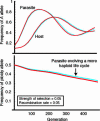Host-parasite interactions and the evolution of ploidy
- PMID: 15252199
- PMCID: PMC503737
- DOI: 10.1073/pnas.0403151101
Host-parasite interactions and the evolution of ploidy
Abstract
Although the majority of animals and plants, including humans, are dominated by the diploid phase of their life cycle, extensive diversity in ploidy level exists among eukaryotes, with some groups being primarily haploid whereas others alternate between haploid and diploid phases. Previous theory has illuminated conditions that favor the evolution of increased or decreased ploidy but has shed little light on which species should be primarily haploid and which primarily diploid. Here, we report a discovery that emerged from host-parasite models in which ploidy levels were allowed to evolve: selection is more likely to favor diploidy in host species and haploidy in parasite species. Essentially, when parasites must evade a host's immune system or defense response, selection favors parasitic individuals that express a narrow array of antigens and elicitors, thus favoring haploid parasites over diploid parasites. Conversely, when hosts must recognize a parasite before mounting a defensive response, selection favors hosts with a broader arsenal of recognition molecules, thus favoring diploid hosts over haploid hosts. These results are consistent with the predominance of haploidy among parasitic protists.
Figures

Similar articles
-
Heterozygote advantage and the evolution of a dominant diploid phase.Genetics. 1992 Dec;132(4):1195-8. doi: 10.1093/genetics/132.4.1195. Genetics. 1992. PMID: 1459436 Free PMC article.
-
Driven apart: the evolution of ploidy differences between the sexes under antagonistic selection.Am Nat. 2014 Jan;183(1):96-107. doi: 10.1086/674025. Epub 2013 Nov 22. Am Nat. 2014. PMID: 24334739
-
Evolution of haploid-diploid life cycles when haploid and diploid fitnesses are not equal.Evolution. 2017 Feb;71(2):215-226. doi: 10.1111/evo.13125. Epub 2016 Dec 1. Evolution. 2017. PMID: 27859032
-
Sperm competition and sperm cooperation: the potential role of diploid and haploid expression.Reproduction. 2008 Mar;135(3):275-83. doi: 10.1530/REP-07-0482. Reproduction. 2008. PMID: 18299420 Review.
-
Evolution in the Cycles of Life.Annu Rev Genet. 2016 Nov 23;50:133-154. doi: 10.1146/annurev-genet-120215-035227. Epub 2016 Sep 8. Annu Rev Genet. 2016. PMID: 27617970 Review.
Cited by
-
Crossing the line: selection and evolution of virulence traits.PLoS Pathog. 2006 May;2(5):e42. doi: 10.1371/journal.ppat.0020042. PLoS Pathog. 2006. PMID: 16733541 Free PMC article. Review.
-
Hyperdiverse gene cluster in snail host conveys resistance to human schistosome parasites.PLoS Genet. 2015 Mar 16;11(3):e1005067. doi: 10.1371/journal.pgen.1005067. eCollection 2015 Mar. PLoS Genet. 2015. PMID: 25775214 Free PMC article.
-
Patterns of genetic variation in populations of infectious agents.BMC Evol Biol. 2007 Jul 13;7:116. doi: 10.1186/1471-2148-7-116. BMC Evol Biol. 2007. PMID: 17629913 Free PMC article.
-
The dynamic nature of eukaryotic genomes.Mol Biol Evol. 2008 Apr;25(4):787-94. doi: 10.1093/molbev/msn032. Epub 2008 Feb 6. Mol Biol Evol. 2008. PMID: 18258610 Free PMC article.
-
Effects of soil nitrogen on diploid advantage in fireweed, Chamerion angustifolium (Onagraceae).Ecol Evol. 2018 Dec 26;9(3):1095-1109. doi: 10.1002/ece3.4797. eCollection 2019 Feb. Ecol Evol. 2018. PMID: 30805143 Free PMC article.
References
-
- Bell, G. (1982) The Masterpiece of Nature: The Evolution and Genetics of Sexuality (Univ. of California, Berkeley).
-
- Mable, B. K. & Otto, S. P. (1998) BioEssays 20, 453–462.
-
- Perrot, V., Richerd, S. & Valero, M. (1991) Nature 351, 315–317. - PubMed
Publication types
MeSH terms
LinkOut - more resources
Full Text Sources

